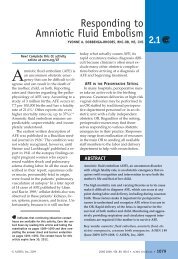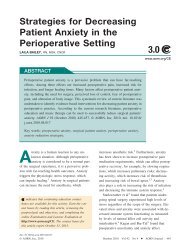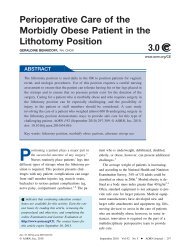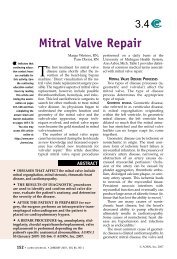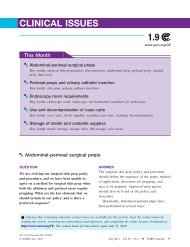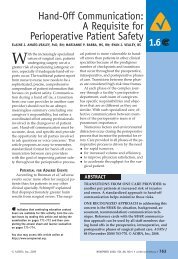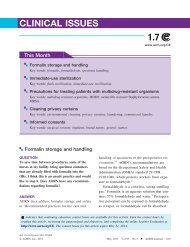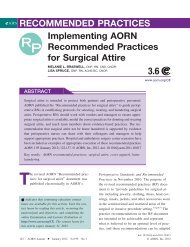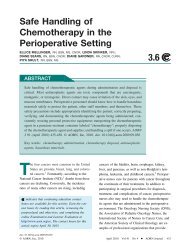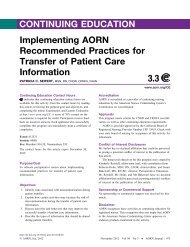Perioperative Pharmacology: Blood Coagulation Modifiers - AORN
Perioperative Pharmacology: Blood Coagulation Modifiers - AORN
Perioperative Pharmacology: Blood Coagulation Modifiers - AORN
Create successful ePaper yourself
Turn your PDF publications into a flip-book with our unique Google optimized e-Paper software.
<strong>Perioperative</strong> <strong>Pharmacology</strong>:<strong>Blood</strong> <strong>Coagulation</strong> <strong>Modifiers</strong>RODNEY W. HICKS, PhD, RN, FNP-BC, FAANP, FAAN; LINDA J. WANZER, MSN, RN, CNOR;BRADLEE GOECKNER, MSN, RN, CNORABSTRACT<strong>Blood</strong> coagulation is the process that results in the formation of a blood clot to stopbleeding from a damaged blood vessel. Various pharmacologic agents can affect thecoagulation process. The American College of Chest Physicians’ evidence-basedpractice guidelines for perioperative management of antithrombotic therapy provideguidance for anticoagulant or antiplatelet therapy and bridge therapy. <strong>Perioperative</strong>nurses must understand the pharmacologic principles of the most common bloodcoagulation modifiers related to perioperative use. The perioperative nurse’s responsibilitiesregarding administration of blood coagulation modifiers include reviewingthe patient’s pertinent laboratory results (eg, prothrombin time, partial thromboplastintime, international normalized ratio), recognizing the underlying conditions thatrequire blood coagulation therapy, and documenting all pertinent information. <strong>Perioperative</strong>nurses also should participate in development of detailed storage andretrieval policies related to heparin. <strong>AORN</strong> J 93 (June 2011) 726-733. © <strong>AORN</strong>, Inc,2011. doi: 10.1016/j.aorn.2011.01.012Key words: thrombolytic, platelet aggregation inhibitor, heparin antagonist, anticoagulant,unfractionated heparin, UFH, low-molecular-weight heparin, LMWH.1.7www.aorn.org/CEindicates that continuing education contacthours are available for this activity. Earn the contacthours by reading this article, reviewing thepurpose/goal and objectives, and completing theonline Examination and Learner Evaluation athttp://www.aorn.org/CE. The contact hours forthis article expire June 30, 2014.<strong>Blood</strong> coagulation is an important processwithin the complex hematologic systemby which a person’s host defense mechanisminitiates action to stop blood loss from adamaged vessel. <strong>Blood</strong> coagulation disorders includeexcessive bleeding (ie, hemorrhage) or obstructiveclotting (ie, thrombosis). Various pharmacologicagents can affect the coagulationprocess and are classified as blood products/modifiers/volume expanders (ie, blood coagulationmodifiers) in the US Department of Veterans Affairsclass index. 1 This class includes agents commonlyknown as anticoagulants, antiplateletagents, thrombolytics, or antifibrinolytics (ie,hemostatic agents). Annually in the United States,more than 250,000 patients who are on someform of anticoagulant or antiplatelet therapy willundergo surgery or a less-invasive procedure. 2<strong>Perioperative</strong> team members are likely to encounterblood coagulation modifiers in practice and,doi: 10.1016/j.aorn.2011.01.012726 <strong>AORN</strong> Journal ● June 2011 Vol 93 No 6 © <strong>AORN</strong>, Inc, 2011
BLOOD COAGULATION MODIFIERSwww.aornjournal.orgtherefore, should have a working knowledge ofsome of the most common agents within eachclass, as well as a thorough knowledge of perioperativeguidelines for the management of antithrombotictherapy.PERIOPERATIVE MANAGEMENT OFANTITHROMBOTIC THERAPYIn June 2008, the American College of ChestPhysicians (ACCP) published an update to itsevidence-based clinical practice guidelines thatprovide direction for perioperative management ofantithrombotic therapy. 2 These guidelines areopenly available to the health care communityand carry the caveat that perioperative antithrombotictherapy is an emerging field. 2(p304) <strong>AORN</strong>’s“Guideline for prevention of venous stasis” summarizesrisk factors for deep vein thrombosis,venous thromboembolism, and pulmonary embolism.3 According to a British guideline for the useand monitoring of heparin, risk originates fromeither the patient, the disorder (Table 1), or thetherapy itself. 4 An additional risk lies with thetype of surgical procedure being performed (Table2). <strong>Perioperative</strong> nurses can use this breadth ofinformation when caring for the patient during thesurgical experience.The ACCP practice guidelines refer to anticoagulantor antiplatelet therapy as vitamin K antagonist(VKA) therapy. The ACCP guidelines providedirection regarding when to discontinue anagent before surgery, when to resume the agentafter surgery, and how to identify which patientsmay require bridge therapy (ie, the transition fromoral anticoagulant to parenteral anticoagulant therapy).The guidelines also describe how to assessthe risk for a thromboembolic event against therisk for bleeding. To determine such risk, the authorsof the guidelines encourage the use ofpatient-centered care principles to individualizepatient care management. 2For patients on VKA therapy who are consideredto be at low risk for a thromboembolicevent, the guidelines recommend stopping theTABLE 1. Patient and Disorder RiskFactors for Deep Vein Thrombosis, VenousThromboembolism, or PulmonaryEmbolism 1,2SourcePatientDisorderRisk factorsAge 40 yearsBirth control pills/estrogen or hormonetherapyChildren: when intervention includesplacement of central venous access orarterial cathetersObesityRecent prolonged travelSmokingAtrial fibrillationBurnsCancer, including history of cancerUndergoing chemotherapy, including historyof chemotherapyCongestive heart failureCerebrovascular accident or recent transientischemic attackDehydration or hypovolemiaHistory (or family history) of thromboticevent(s)History of valvular surgeryInfection or sepsisInflammatory bowel diseaseNephritic syndromeOrthopedic fractures, especially lower limbPatient’s condition that requires a stay in acritical care unitPregnancy or postpartum 1 monthRecent myocardial infarctionTraumaVaricosities1. Baglin T, Barrowcliffe TW, Cohen A, Greaves M; British Committeefor Standards in Haematology. Guidelines on the use and monitoringof heparin. Br J Haematol. 2006;133(1):19-34.2. <strong>AORN</strong> guideline for prevention of venous stasis. In: <strong>Perioperative</strong>Standards and Recommended Practices. Denver, CO: <strong>AORN</strong>, Inc;2011:653-670.VKA agent five days before surgery. 2(2.1-2.3) Thesurgeon, in collaboration with the primary carephysician who ordered the initial therapy, shouldcheck the international normalized ratio (INR)before surgery, and, if it is elevated, the surgeonor primary care physician might order an oraldose of vitamin K. For practical purposes, this<strong>AORN</strong> Journal 727
BLOOD COAGULATION MODIFIERSwww.aornjournal.orgFigure 1. The clotting cascade. Lehne RA. Anticoagulant, antiplatelet, and thrombolytic drugs. In: <strong>Pharmacology</strong>for Nursing Care. 7th ed. St Louis, MO; 2010:594-618. Reprinted with permission from Saunders Elsevier.heparin can occur within two minutes after injection,and the agent has a half-life of approximately60 minutes. After hepatic metabolism,heparin is excreted through the renal system inapproximately six hours. These characteristicsmake it difficult to ascertain the optimal safedose. Often, the dose is titrated with guidancefrom a weight-based nomogram and laboratorymonitoring of activated partial thromboplastintime (PTT). 5 The anticoagulant effect of UFH canbe rapidly reversed by using protamine sulfate. 4Adverse EffectsHeparin is considered a high-alert medicationby the Institute for Safe Medication Practices,given its narrow therapeutic range. 6 High-alertmedications carry an enhanced risk of causingsignificant patient harm. The leading adversereaction associated with heparin is hemorrhage;bleeding can occur in any site. Heparin, therefore,is contraindicated in patients during andimmediately after surgery of the eye, brain, orspinal column. 7 Other adverse reactions includethrombocytopenia, heparin-induced thrombocytopenia,and hypersensitivity (eg, measles-like skinrash, urticaria, angioedema, bronchospasm). 7Heparin also has been implicated in perioperativemedication errors (Table 3), including at leastone error that may have caused a patient’s death. 8Heparin is packaged in various concentrations,expressed as units per milliliters, and the totalcontent of vials differ, two characteristics thatpredispose the agent to error involvement. 7,8Medication InteractionsNurses must recognize that concurrent use ofother platelet-depressing agents is contraindicatedbecause of the anticoagulant properties of<strong>AORN</strong> Journal 729
June 2011 Vol 93 No 6 HICKS—WANZER—GOECKNERTABLE 3. Frequency of Heparin MedicationErrors in <strong>Perioperative</strong> CareProducts N % CommentsOutpatientsurgery 1 36 1.9 Based on 2,979 records,3,323 selections, and384 unique productsreportedPreoperativeholdingarea 2 16 2.2 Based on 631 records,719 selections, and139 unique productsreportedOperatingroom 3 143 3.9 Based on 3,298 records,3,703 selections, and343 unique productsreportedPostanesthesiacare unit 4 74 2.2 Based on 2,874 records,3,312 selections, and366 unique productsreported1. Rod Hicks, PhD, nurse researcher, written communication,February 21, 2011; data on file at US Pharmacopoeia.2. Table 2-8. Most commonly reported products in preoperativeholding area medication errors by population. In: MEDMARX® DataReport: A Chartbook of Medication Error Findings from <strong>Perioperative</strong>Settings from 1998-2005. Rockville, MD: USP Center for theAdvancement of Patient Safety; 2006:56.3. Table 3-8. Most commonly reported products involved inoperating room medication errors by population. In: MEDMARX®Data Report: A Chartbook of Medication Error Findings from<strong>Perioperative</strong> Settings from 1998-2005. Rockville, MD: USP Centerfor the Advancement of Patient Safety; 2006:79.4. Table 4-8. Most commonly reported products involved inpostanesthesia care unit medication errors by population. In:MEDMARX® Data Report: A Chartbook of Medication Error Findingsfrom <strong>Perioperative</strong> Settings from 1998-2005. Rockville, MD: USPCenter for the Advancement of Patient Safety; 2006:103.heparin. Over-the-counter agents such as aspirinand aspirin-containing agents would clearly becontraindicated. Nutritional supplements suchas garlic, ginkgo, and ginseng have less empiricalevidence of significant drug-drug interactionsbut are generally contraindicated for thesurgical patient. 9LOW-MOLECULAR-WEIGHT HEPARINThe class of agents known as LMWH haveshorter molecular chains and lower molecularweights than UFH agents. The molecules ofLMWH are as effective as those of UFH; however,LMWH agents are generally easier to use asfixed dosages, and LMWH therapy requires lesslaboratory monitoring, which makes these agentsideal for outpatient use. Other approved uses areeither prophylactic in nature, such as preventionof deep vein thrombosis after surgery and preventionof ischemia in certain cardiac conditions, ortherapeutic uses, such as treatment of confirmeddeep vein thrombosis. 7After subcutaneous administration, LMWHagents achieve high bioavailability because theseagents bind minimally to plasma proteins or macrophages,which leaves more agent available toproduce the anticoagulation effect. 5,7 These agentswork mainly by inactivating factor antifactor X(Xa) 5,7 and by exerting weak antithrombin activities.The peak effect of a dose occurs after threehours, and the half-life is up to six times longerthan for UFH. 7 Metabolism occurs in the liverfollowed by renal elimination. Because of the predictabilityof LMWH effects, dosages can be administeredeither once or twice daily. Routinelaboratory monitoring for anticoagulation is generallynot indicated; however, laboratories canmeasure Xa levels to report the effect on clottingmechanisms. 5Adverse EffectsThe risk of excessive bleeding remains the greatestadverse event; however, such effects are lesslikely to occur with LMWH than with UFH. Patientsat greatest risk for hemorrhage have low body weight; are older than 70 years; have experienced trauma; are concomitantly using agents that affecthemostasis (eg, aspirin, nonsteroidal antiinflammatorydrugs); or have impaired renal function.In addition, potential adverse effects are heightenedin patients who are undergoing spinal anesthesia.Reversing the anticoagulant effect ofLMWH can be accomplished by using protaminesulfate. 5,7730 <strong>AORN</strong> Journal
BLOOD COAGULATION MODIFIERSwww.aornjournal.orgMedication InteractionsThe same medication interactions need to be consideredfor LMWH administration as for UFHadministration. These include contraindicated useof over-the-counter, platelet-depressing agents (eg,aspirin, aspirin-containing agents, garlic, ginkgo,ginseng).The MEDMARX report of perioperative medicationerrors noted instances in which LMWHagents were involved in errors. 8 These agentswere not reported as leading agents associatedwith errors in the outpatient surgery setting or inthe OR; however, nine errors were reported in thepreoperative holding area, and seven errors thatinvolved elderly patients were reported in thepostanesthesia care unit. 8(p56,103)ROLES AND RESPONSIBILITIES OF THEPERIOPERATIVE NURSE<strong>Perioperative</strong> nurses can easily incorporate theACCP guidelines into practice. The ACCP guidelinesrecommend obtaining appropriate laboratorytests before surgery to minimize the risk of excessivebleeding. Identifying that a patient has inadequateprothrombin time (PT), PTT, and INR levelsdisrupts the surgical schedule, disrupts thesurgeon’s clinic schedule, and negatively affectspatient satisfaction if this occurs during preoperativecare.SchedulingOne of the most difficult areas in which to incorporatethe guidelines is in the scheduling department.Surgical scheduling must take into considerationthe patient’s access to a laboratory, thelaboratory’s ability to report results in a timelyfashion, and the surgical team’s ability to takeaction on the results. Such coordination requiresmore than just calling the scheduling desk andobtaining the appointed time for the procedure.Until seamless transfer of medical records betweenproviders’ offices and health care facilitiesis functional and fully in place, there remains theneed to enhance the type of information collectedat the point of scheduling to identify patients onVKA therapy. Research opportunities include investigatingwhether these patients are best suitedto be scheduled as the first procedure of the dayor should routinely be scheduled as a later procedureof the day.Documentation and Communication ofPatient InformationAt the point of intake, such as an outpatientsurgery setting or another location (eg, preregistrationand testing center), documentation of thepatient’s medical and surgical history and medicationreconciliation can provide safeguards. Informationreviewed should include the primary careprovider’s and surgeon’s respective consultationnotes pertaining to VKA therapy. Nurses mustrecognize the underlying conditions that requireVKA therapy. Merely asking questions such as“What medications are you currently taking?” isnot adequate. Rather, the interview process mustbe sufficient to identify whether the VKA is onhold and for how long, or whether the patient hastransitioned or should transition to bridge therapy.Information obtained at this stage must be documentedand shared with other members of thesurgical team and throughout the perioperativecontinuum of care.Preoperative AssessmentDuring the preoperative assessment phase, thenurse should review the patient’s pertinent laboratoryresults. A sudden decrease in the PTT, PT,or INR may be reported by the laboratory system.The nurse must carefully consider and communicatethese findings. If patients are arriving earlyto have laboratory work done, then how the nursecompletes the laboratory requisitions is important.Rather than merely putting “preoperative” or asimilar designation in the indication for the laboratorytest, the nurse should complete the formwith detailed information, such as “holding anticoagulantbefore surgery.” The reason for thisdetailed documentation is that many laboratorysystems track trends in patient results. Detaileddocumentation also provides sufficient rationale<strong>AORN</strong> Journal 731
June 2011 Vol 93 No 6 HICKS—WANZER—GOECKNERfor the test, which has financial implications forbilling practices.Storage and RetrievalInstitutions are encouraged to have detailedstorage and retrieval policies related to heparingiven its high-alert status and the various concentrationsand packaging sizes on the market.Although independent double checks of heparinremain an important task, perhaps a strongersafety net would be to have bar-code verificationat the point of stocking and retrieving fromstorage devices. The emphasis here is slightlydifferent than for bedside bar-code medicationadministration. Bar-code verification during theprocess of stocking the storage device reinforcesthat the correct strength of the agent isin the right storage bin and, ultimately, in thehands of the practitioner. <strong>Perioperative</strong> nursesshould be prepared to collaborate with pharmaciststo ensure that the safest and most practicalpolicies are developed and then implemented tosupport this process.<strong>Perioperative</strong> ConsiderationsWithin the OR itself, vial concentrations againmust be affirmed as the medication is moved betweenthe circulating nurse and scrub person orother members of the surgical team. All originalcontainers should be retained until the patient exitsthe operating suite. 10 Also, within the OR,nurses must recognize the hazards of prolongedprocedures and patient positioning as risk factorsfor complications. 3An additional perioperative consideration forthe care of patients who are at risk for experiencinga thromboembolic event centers aroundthe potential effect of intentional use of clottingagents to support hemostasis during surgery.This practice is a concern for patients alreadyat risk for clotting who have had their VKAtemporarily withheld because this could placethese patients at risk for clots. Circulatingnurses should have protamine sulfate readilyavailable for administration to counter the residualeffects of VKA therapy and augment hemostasisfor these vulnerable patients. 11 Fromthe intraoperative phase through discharge, it isessential that all perioperative practitionersclosely observe these patients’ laboratory values(eg, PT, PTT) to address acute adjustments tothe patient’s medical regimen when VKA therapyis resumed.Postanesthesia care unit nurses may be involvedin administering either UFH or LMWH.The nurse should verify medication orders witha pharmacist. Furthermore, nurses should understandwhy the agent was ordered and reviewpertinent laboratory results before administeringadditional doses. Finally, the nurse must clearlydocument all doses administered.CONCLUSIONTo summarize the clinical practice guidelinesfor antithrombotic therapy from the viewpointof perioperative nursing, it is important to identifywhich patients are taking VKA or are undergoingantiplatelet therapy before surgery.This identification must occur in a timely fashionto prevent adverse outcomes for the patientand disruption of the surgical schedule. Part ofthe identification process includes knowing thepatient’s underlying pathology and determiningthe patient’s level of risk for either bleeding orexperiencing a thromboembolic event. The typeof therapy directs practitioners regarding theneed for and frequency of laboratory monitoring.<strong>Perioperative</strong> nurses should be familiarwith the various coagulation tests available andschedule procedures in a manner that allowssufficient time to review any laboratory data.Communication of clinical information amongall members of the health care team about patientstaking VKA remains a priority to reducerisk of hemorrhage or untoward thromboembolicevents.Editor’s note: The views expressed are those ofthe authors and do not reflect the official policy732 <strong>AORN</strong> Journal
BLOOD COAGULATION MODIFIERSwww.aornjournal.orgor position of the Uniformed Services Universityof the Health Sciences, the Department of the Defense,or the US Government.References1. National formulary: VA class index. United States Departmentof Veterans Affairs. http://www.pbm.va.gov/NationalFormulary.aspx. Accessed January 17, 2011.2. Douketis JD, Berger PB, Dunn AS, et al; AmericanCollege of Chest Physicians. The perioperative managementof antithrombotic therapy: American College ofChest Physicians Evidence-Based Clinical PracticeGuidelines (8th Edition). Chest. 2008;133(6 Suppl):299S-339S.3. <strong>AORN</strong> guideline for prevention of venous stasis. In:<strong>Perioperative</strong> Standards and Recommended Practices.Denver, CO: <strong>AORN</strong>, Inc; 2011:653-670.4. Baglin T, Barrowcliffe TW, Cohen A, Greaves M; BritishCommittee for Standards in Haematology. Guidelineson the use and monitoring of heparin. Br JHaematol. 2006;133(1):19-34.5. Becker RC, Fintel DJ, Green D. Antithrombotic Therapy.4th ed. West Islip, NY: Professional Communications,Inc; 2006.6. ISMP’s list of high-alert medications. Institute for SafeMedication Practices. http://www.ismp.org/Tools/highalertmedications.pdf. Accessed January 17, 2011.7. Lehne RA. Anticoagulant, antiplatelet, and thrombolyticdrugs. In: <strong>Pharmacology</strong> for Nursing Care. 7th ed. StLouis, MO: Saunders Elsevier; 2010:559-582.8. Hicks RW, Becker SC, Cousins DD. MEDMARXData Report: A Chartbook of Medication ErrorFindings from the <strong>Perioperative</strong> Setting from 1998-2005. Rockville, MD: USP Center for the Advancementof Patient Safety; 2006.9. Ang-Lee MK, Moss J, Yuan CS. Herbal medicines andperioperative care. JAMA. 2001;286(2):208-216.10. <strong>AORN</strong> guidance statement: Safe medication practicesin perioperative settings across the life span. In: <strong>Perioperative</strong>Standards and Recommended Practices. Denver,CO: <strong>AORN</strong>, Inc; 2010:665-671.11. Neveleff DJ, Kraiss LW, Schulman CS. Implementingmethods to improve perioperative hemostasis in thesurgical and trauma settings. <strong>AORN</strong> J. 2010;92(5):S1-S15.Rodney W. Hicks, PhD, RN, FNP-BC,FAANP, FAAN, is a nurse researcher and consultant,Lubbock, TX. Dr Hicks has no declaredaffiliation that could be perceived asposing a potential conflict of interest in thepublication of this article.Linda J. Wanzer, MSN, RN, CNOR, COL(Ret), is the director of the <strong>Perioperative</strong> ClinicalNurse Specialist Program and assistant professorof nursing at the Uniformed ServicesUniversity of the Health Sciences, GraduateSchool of Nursing, Bethesda, MD. COLWanzer has no declared affiliation that couldbe perceived as posing a potential conflict ofinterest in the publication of this article.BradLee Goeckner, MSN, RN, CNOR,LCDR, NC, USN, is a perioperative clinicalnurse specialist and directorate of surgical servicesat NAVMEDCEN, San Diego, CA.LCDR Goeckner has no declared affiliation thatcould be perceived as posing a potential conflictof interest in the publication of this article.<strong>AORN</strong> Journal 733
EXAMINATIONCONTINUING EDUCATION PROGRAM<strong>Perioperative</strong> <strong>Pharmacology</strong>: <strong>Blood</strong><strong>Coagulation</strong> <strong>Modifiers</strong>1.7www.aorn.org/CEPURPOSE/GOALTo educate perioperative nurses about perioperative use of blood coagulation modifiers.OBJECTIVES1. Identify types of blood coagulation modifiers.2. Discuss practice guidelines for perioperative management of antithrombotictherapy.3. Discuss considerations of vitamin K antagonist (VKA) therapy.4. Differentiate between low-molecular-weight heparin (LMWH) and unfractionatedheparin (UFH).5. Explain nursing responsibilities for perioperative use of blood coagulationmodifiers.The Examination and Learner Evaluation are printed here for your convenience.To receive continuing education credit, you must complete the Examinationand Learner Evaluation online at http://www.aorn.org/CE.QUESTIONS1. <strong>Blood</strong> coagulation modifiers include agents commonlyknown as1. anticoagulants.2. antifibrinolytics.3. antiplatelet agents.4. beta-adrenergic blockers.5. thrombolytics.a. 1 and 2 b. 3, 4, and 5c. 1, 2, 3, and 5 d. 1, 2, 3, 4, and 52. According to a British guideline, risk originatesfrom the1. patient.2. disorder.3. therapy.4. type of surgical procedure.a. 1 and 2 b. 2 and 4c. 1, 2, and 3 d. 1, 2, 3, and 43. The American College of Chest Physicians(ACCP) practice guidelines provide directionregarding1. how to assess the risk for a thromboembolicevent against the risk for bleeding.2. how to identify which patients may requirebridge therapy.3. how to select agents to treat specific clinicalscenarios.4. when to discontinue the agent before surgery.5. when to resume the agent after surgery.a. 4 and 5 b. 1, 2, and 3c. 1, 2, 4, and 5 d. 1, 2, 3, 4, and 5734 <strong>AORN</strong> Journal ● June 2011 Vol 93 No 6 © <strong>AORN</strong>, Inc, 2011
CE EXAMINATIONwww.aornjournal.org4. For patients on VKA therapy who are consideredto be at low risk for a thromboembolicevent, the ACCP guidelines recommend resumingthe VKA agent between _____________after the surgical procedure, when there is evidencethat adequate hemostasis has beenachieved.a. the conclusion of the procedure and 12 hoursb. 12 and 24 hoursc. 24 and 36 hoursd. 36 and 48 hours5. The advantages of LMWH over UFH include thatLMWH agents1. can be administered in the outpatient setting.2. do not necessitate close laboratory monitoring.3. have uniform dosing, regardless of age orweight.4. achieve peak effect faster.a. 1 and 2 b. 2 and 4c. 1, 2, and 3 d. 1, 2, 3, and 46. Characteristics that make it difficult to ascertainthe optimal safe dose of UFH include that1. after hepatic metabolism, heparin is excretedthrough the renal system in about six hours.2. the half-life of heparin is approximately 60minutes.3. the peak effect of a single IV dose of heparincan occur within two minutes after injection.a. 1 and 2 b. 1 and 3c. 2 and 3 d. 1, 2, and 37. The anticoagulant effect of UFH can be rapidlyreversed by usinga. choline salicylate.b. papaverine.c. protamine sulfate.d. streptokinase.8. Low-molecular-weight heparin agents achievehigh bioavailability because these agents bindminimally to plasma proteins or macrophages,thus leaving more agent available for producingthe anticoagulation effect.a. true b. false9. The risk of excessive bleeding is the greatest adverseevent from heparin administration; however,such effects are less likely to occur witha. LMWH.b. UFH.10. At the point of intake, information that the nurseshould review includes1. the patient’s currently prescribed medications.2. whether the patient transitioned or should transitionto bridge therapy.3. whether a VKA agent is on hold and for howlong.4. underlying conditions that require VKAtherapy.5. the primary care provider’s and surgeon’s consultationnotes that pertain to VKA therapy.a. 4 and 5 b. 1, 2, and 3c. 1, 2, 3, and 4 d. 1, 2, 3, 4, and 5The behavioral objectives and examination for this program were prepared by Rebecca Holm, MSN, RN, CNOR, clinical editor,with consultation from Susan Bakewell, MS, RN-BC, director, Center for <strong>Perioperative</strong> Education. Ms Holm and Ms Bakewellhave no declared affiliations that could be perceived as posing potential conflicts of interest in the publication of this article.<strong>AORN</strong> Journal 735
LEARNER EVALUATIONCONTINUING EDUCATION PROGRAM<strong>Perioperative</strong> <strong>Pharmacology</strong>: <strong>Blood</strong><strong>Coagulation</strong> <strong>Modifiers</strong>1.7www.aorn.org/CEThis evaluation is used to determine the extent towhich this continuing education program metyour learning needs. Rate the items as describedbelow.OBJECTIVESTo what extent were the following objectives of thiscontinuing education program achieved?1. Identify types of blood coagulation modifiers.Low 1. 2. 3. 4. 5. High2. Discuss practice guidelines for perioperative managementof antithrombotic therapy.Low 1. 2. 3. 4. 5. High3. Discuss considerations of vitamin K antagonisttherapy. Low 1. 2. 3. 4. 5. High4. Differentiate between low-molecular-weight heparinand unfractionated heparin.Low 1. 2. 3. 4. 5. High5. Explain nursing responsibilities for perioperativeuse of blood coagulation modifiers.Low 1. 2. 3. 4. 5. HighCONTENT6. To what extent did this article increase yourknowledge of the subject matter?Low 1. 2. 3. 4. 5. High7. To what extent were your individual objectivesmet? Low 1. 2. 3. 4. 5. High8. Will you be able to use the information from thisarticle in your work setting? 1. Yes 2. No9. Will you change your practice as a result of readingthis article? (If yes, answer question #9A. Ifno, answer question #9B.)9A. How will you change your practice? (Select allthat apply)1. I will provide education to my team regardingwhy change is needed.2. I will work with management to change/implement a policy and procedure.3. I will plan an informational meeting withphysicians to seek their input and acceptanceof the need for change.4. I will implement change and evaluate theeffect of the change at regular intervals untilthe change is incorporated as best practice.5. Other:9B. If you will not change your practice as a resultof reading this article, why? (Select all thatapply)1. The content of the article is not relevant tomy practice.2. I do not have enough time to teach othersabout the purpose of the needed change.3. I do not have management support to makea change.4. Other:10. Our accrediting body requires that we verifythe time you needed to complete the 1.7 continuingeducation contact hour (102-minute)program:This program meets criteria for CNOR and CRNFA recertification, as well as other continuing education requirements.<strong>AORN</strong> is accredited as a provider of continuing nursing education by the American Nurses Credentialing Center’s Commission on Accreditation.<strong>AORN</strong> recognizes these activities as continuing education for registered nurses. This recognition does not imply that <strong>AORN</strong> or the American Nurses Credentialing Centerapproves or endorses products mentioned in the activity.<strong>AORN</strong> is provider-approved by the California Board of Registered Nursing, Provider Number CEP 13019. Check with your state board of nursing for acceptance of thisactivity for relicensure.Event: #11509; Session: #0001 Fee: Members $8.50, Nonmembers $17The deadline for this program is June 30, 2014.A score of 70% correct on the examination is required for credit. Participants receive feedback on incorrect answers. Eachapplicant who successfully completes this program can immediately print a certificate of completion.736 <strong>AORN</strong> Journal ● June 2011 Vol 93 No 6 © <strong>AORN</strong>, Inc, 2011



